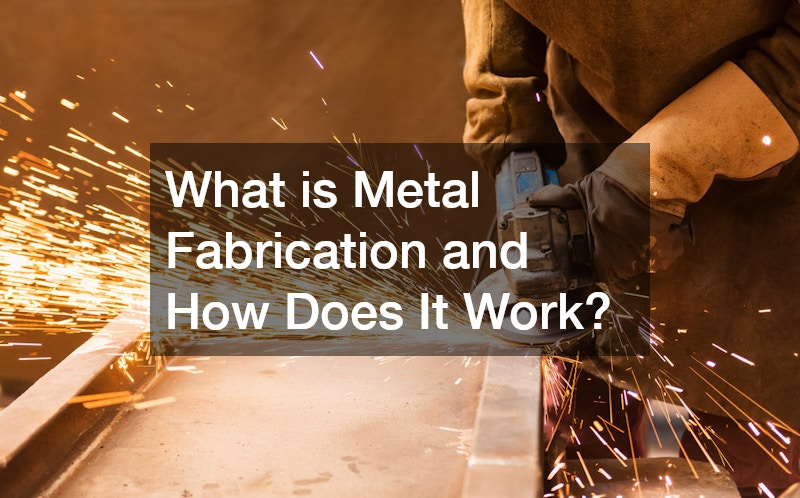Metal fabrication is a vital process in manufacturing that transforms raw metal materials into usable parts and products. From the frame of a car to structural components in buildings, metal fabrication is at the heart of many items we rely on every day.
But what exactly does this process involve, and how does it all come together?
Understanding metal fabrication provides insight into how metal is shaped, formed and assembled into finished products across industries such as construction, automotive, mining and agriculture.
The Role of Metal Fabrication in Industry
Metal fabrication is more than just welding or cutting sheets of metal. It involves a sequence of processes that can include cutting, bending, welding and assembling metals into specific shapes or structures. Each step is carefully planned and executed to meet the unique design and performance requirements of a project.
In Australia, metal fabrication is a key component of infrastructure development. Whether it’s creating steel beams for commercial buildings or custom brackets for machinery, fabricators play an essential role in turning blueprints into physical parts that stand the test of time.
Breaking Down the Fabrication Process
The metal fabrication process often starts with design and planning. Engineers and designers use computer-aided design (CAD) software to create detailed plans that fabricators will follow. These designs determine the dimensions, materials and techniques needed for the job.
Once the design is approved, the next step is sourcing the right type of metal. Common choices include aluminium, stainless steel and carbon steel. Each metal is selected based on factors like strength, corrosion resistance and weight.
Cutting is usually the first action taken to begin shaping the material. This can be done using a range of equipment from plasma cutters and lasers to waterjets and shears. The goal is to trim the raw metal into workable sections according to the design specifications.
Bending comes next, often performed using press brakes or rolling machines to shape the metal into the desired form. Then comes welding or fastening, where the cut and bent parts are joined together. Depending on the complexity of the project, different welding techniques might be used to ensure strong, clean joints.
Finally, surface finishing methods such as grinding, sandblasting or powder coating are applied. These techniques not only improve the look of the piece but also protect it from rust, wear or damage during use.
Applications Across Various Sectors
Metal fabrication is everywhere—from large construction projects to small custom builds. In the automotive industry, fabricated metal parts make up key elements of a vehicle’s structure, like chassis components, panels and exhaust systems. In mining, fabrication is used to create heavy-duty frames, conveyors and guarding for equipment.
Agriculture also relies heavily on fabricated metal for the production of fencing, grain silos and trailer parts. In the energy sector, custom fabrication is used for pipelines, wind turbine frames and solar panel mounts. Metal fabrication is so versatile it supports countless other industries, including defence, shipping, public infrastructure and even fine art installations.
Why Skilled Fabricators Matter
The success of any fabrication project depends on the skill of the fabricators. They must be able to read technical drawings, operate specialised tools and understand the behaviour of different metals under heat and pressure. It’s a trade that demands both hands-on expertise and a solid understanding of engineering principles.
Australian fabricators are also required to adhere to safety and quality standards laid out by national codes. This ensures that each piece they produce is not only functional but also safe for use in high-pressure environments. The best fabricators deliver consistent results, adapt to custom project needs and communicate clearly with builders, engineers and project managers.
Advancements in Metal Fabrication Technology
The field of metal fabrication has seen major changes thanks to technological advancements. CNC (computer numerical control) machinery allows for incredibly precise cuts and bends, which boosts productivity and reduces human error. Automation has also made it easier to handle larger workloads while maintaining consistent output quality.
Laser technology, 3D modelling and robotic welding are now common tools in advanced fabrication shops. These upgrades make the fabrication process faster, more accurate and more cost-effective in the long run. They also allow for greater flexibility in producing one-off prototypes or large-scale production runs.
Digital integration means that data can flow seamlessly from design software to the fabrication floor, improving workflow and reducing the risk of mistakes. These developments are especially important for projects where timelines are tight and margins for error are small.
Final Thoughts
Metal fabrication is a core part of modern construction and manufacturing. It turns raw metals into structures and products that serve vital roles in homes, businesses and infrastructure across the country. With the help of skilled tradespeople and cutting-edge technology, metal fabrication delivers solutions that are strong, durable and highly customisable.
As industries continue to grow and innovate, the demand for precise, efficient metal fabrication remains steady. Understanding how it works not only highlights its importance but also shows the value it brings to everything from towering buildings to finely tuned machinery.
Whether you’re planning a custom build or simply curious about how your tools and structures come to life, knowing the process behind metal fabrication opens the door to appreciating the craftsmanship and technical skill that goes into every finished piece.

